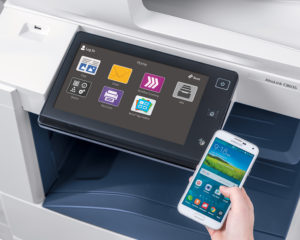There’s been lots of attention on the X’s lately. Not just X as in Xerox, but X as in User Experience or UX, Customer Experience or CX and Digital Transformation or DX. And surprisingly, at the intersection of these three trends, we find yet one more acronym – MPS, aka Managed Print Services.
Now that managed print and document services have moved up the enterprise value chain, you’ll find clear connections to processes, documents and users that impact UX, DX and CX. And because there’s impact, there’s opportunity to influence it. In each case, MPS can support your UX, CX and DX goals.
Let’s break it down X by X, if you will. Then we’ll connect the dots between each X and the supporting MPS benefits and even down to the device capabilities, because the device matters more than you might realize.
CX: Customer Experience and Devices – Making customers happy and loyal
When customer touch points involve documents and processes, intelligent multifunction devices contribute to a positive experience.
- Customers have their forms and other information accepted at point of service or contact.
- Customers can get a printed document delivered at point of need.
- Document quality is professional, consistent and appealing.
- Breakthrough customer experience frees users from traditional paper-bound processes
UX: User Experience and Devices – Making employees happy and productive
You may think using an office printer or scanner is no big deal, and it shouldn’t be. But if you’re not making each user interaction productive and cost-effective, it becomes a big deal. How often does a bad print or scan experience impact productivity somewhere in your business every day? That’s a loss.
A good user experience at the MFP saves hours of accumulated employee time. Imagine even doing something as skilled and complicated as translations at your office MFP! (BTW, you can.) Scan and route confidential documents automatically with speed and security.
 The latest devices deliver consistent, quality UX through a balance of hardware technology and software capability. Nowhere is this better demonstrated than in the user interface, which resets the bar to include capacitive, 5-inch color touch screens. The interfaces offer the familiar tap, swipe and pinch “mobile” experience. Task-focused apps share a common look and feel and reduce the steps needed to complete repetitive jobs, effectively decreasing “time on task.” The interface layout clearly guides users through any job from start to finish and uses fewer steps to complete even the most complex jobs.
The latest devices deliver consistent, quality UX through a balance of hardware technology and software capability. Nowhere is this better demonstrated than in the user interface, which resets the bar to include capacitive, 5-inch color touch screens. The interfaces offer the familiar tap, swipe and pinch “mobile” experience. Task-focused apps share a common look and feel and reduce the steps needed to complete repetitive jobs, effectively decreasing “time on task.” The interface layout clearly guides users through any job from start to finish and uses fewer steps to complete even the most complex jobs.
The new user experience standard for office devices includes capabilities that:
- Ensure all users get the capabilities they need with feature access control.
- Reduce user interactions and guide users if they have a problem.
- Improve overall reliability through application defaults to ensure jobs print as desired.
- Let each user manage their jobs and create the experience that works for them.
- Seamlessly import existing contacts into a device for faster document sharing.
With newfound time and more support from their office technology, knowledge workers can focus on the high-value stuff. Intelligent devices become “workplace assistants” that help employees, instead of slowing them down.



